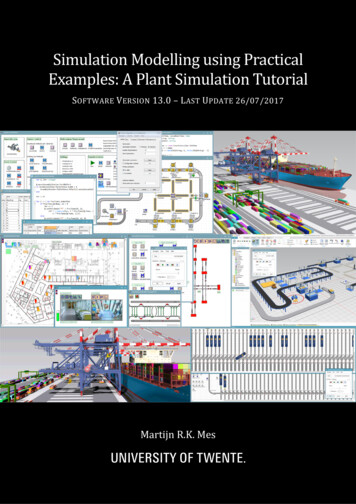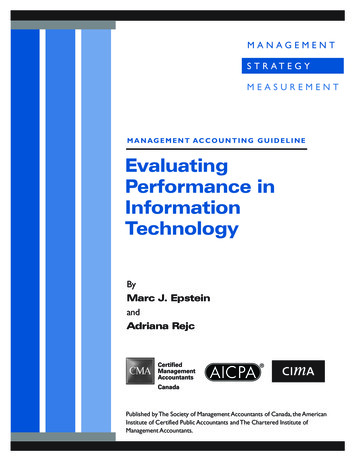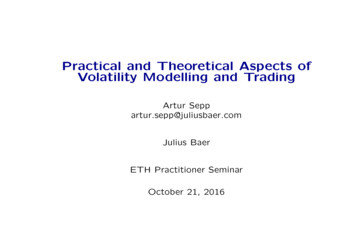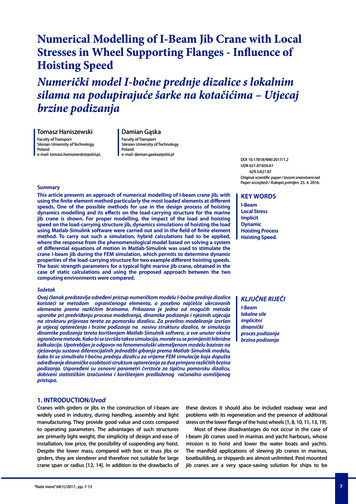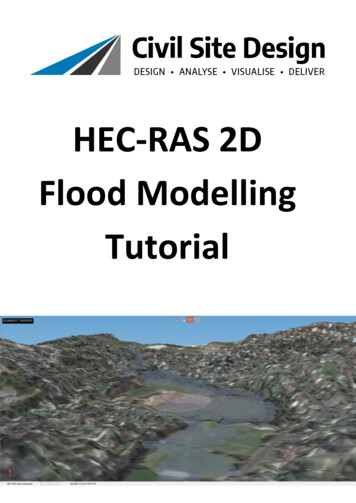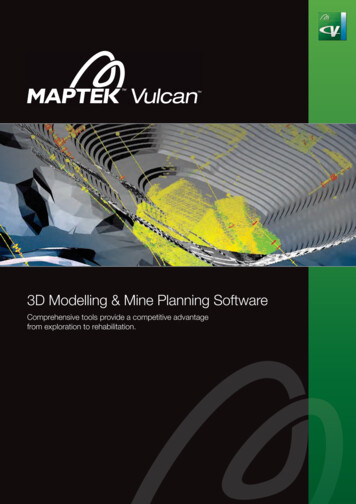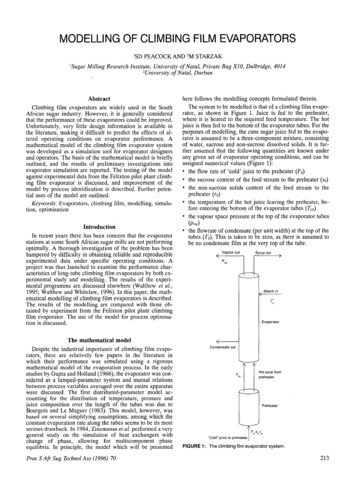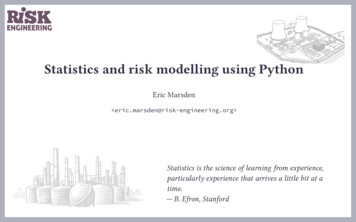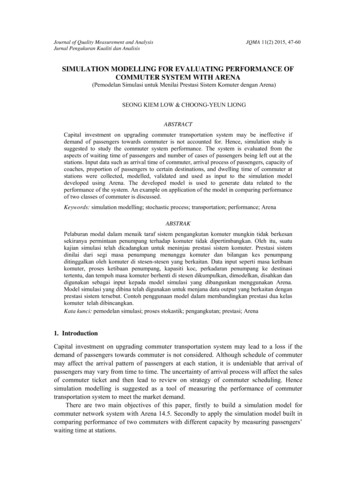
Transcription
JQMA 11(2) 2015, 47-60Journal of Quality Measurement and AnalysisJurnal Pengukuran Kualiti dan AnalisisSIMULATION MODELLING FOR EVALUATING PERFORMANCE OFCOMMUTER SYSTEM WITH ARENA(Pemodelan Simulasi untuk Menilai Prestasi Sistem Komuter dengan Arena)SEONG KIEM LOW & CHOONG-YEUN LIONGABSTRACTCapital investment on upgrading commuter transportation system may be ineffective ifdemand of passengers towards commuter is not accounted for. Hence, simulation study issuggested to study the commuter system performance. The system is evaluated from theaspects of waiting time of passengers and number of cases of passengers being left out at thestations. Input data such as arrival time of commuter, arrival process of passengers, capacity ofcoaches, proportion of passengers to certain destinations, and dwelling time of commuter atstations were collected, modelled, validated and used as input to the simulation modeldeveloped using Arena. The developed model is used to generate data related to theperformance of the system. An example on application of the model in comparing performanceof two classes of commuter is discussed.Keywords: simulation modelling; stochastic process; transportation; performance; ArenaABSTRAKPelaburan modal dalam menaik taraf sistem pengangkutan komuter mungkin tidak berkesansekiranya permintaan penumpang terhadap komuter tidak dipertimbangkan. Oleh itu, suatukajian simulasi telah dicadangkan untuk meninjau prestasi sistem komuter. Prestasi sistemdinilai dari segi masa penumpang menunggu komuter dan bilangan kes penumpangditinggalkan oleh komuter di stesen-stesen yang berkaitan. Data input seperti masa ketibaankomuter, proses ketibaan penumpang, kapasiti koc, perkadaran penumpang ke destinasitertentu, dan tempoh masa komuter berhenti di stesen dikumpulkan, dimodelkan, disahkan dandigunakan sebagai input kepada model simulasi yang dibangunkan menggunakan Arena.Model simulasi yang dibina telah digunakan untuk menjana data output yang berkaitan denganprestasi sistem tersebut. Contoh penggunaan model dalam membandingkan prestasi dua kelaskomuter telah dibincangkan.Kata kunci: pemodelan simulasi; proses stokastik; pengangkutan; prestasi; Arena1. IntroductionCapital investment on upgrading commuter transportation system may lead to a loss if thedemand of passengers towards commuter is not considered. Although schedule of commutermay affect the arrival pattern of passengers at each station, it is undeniable that arrival ofpassengers may vary from time to time. The uncertainty of arrival process will affect the salesof commuter ticket and then lead to review on strategy of commuter scheduling. Hencesimulation modelling is suggested as a tool of measuring the performance of commutertransportation system to meet the market demand.There are two main objectives of this paper, firstly to build a simulation model forcommuter network system with Arena 14.5. Secondly to apply the simulation model built incomparing performance of two commuters with different capacity by measuring passengers’waiting time at stations.
Seong Kim Low & Choong-Yeun LiongThe paper is organised as follow: Section 2 contains a literature review related to variousstudy on measurement of transportation system performance, simulation modelling andapplication of the Arena software in simulation modelling. In Section 3 strategies used toachieve the objectives mentioned in this article are discussed. Section 4 shows thedevelopment of simulation model for the commuter transportation system. Section 5illustrates the application of simulation model in comparing performance of two commuterswith different capacity by measuring passengers’ waiting time at stations and its outputanalysis. Conclusion is made in Section 6 followed by recommendations for future research.2. Literature Review2.1. Measurement for Performance of Transportation SystemThere are different types of indicators to measure the performance of a transportation system.Krueger (1999) suggested the application of Parametric Model in Canadian National Railwayfor improvement of track asset utilisation through measurement and monitoring of systemtrack capacity. Martínez et al. (2001) built a SIMAN-Arena model of the train system inUnited States of America (USA) that allow analysis on track layout, operation strategies,modal coordination, on-time performance and compare schedule operation and headwayoperation of the system. Quan et al. (2004) used graphical technique to develop deadlock-freealgorithm for dispatching each train to its destination with minimal travel time whileconsidering the speed limit constraint and headways between trains in Los Angeles County,USA. Hofman and Madsen (2005) studied factors that affect the robustness in trainscheduling and studied scheduling recovery methods by modelling train network in Denmarkusing simulation tool. Alfieri et al. (2006) presented solution for effective railway circulationon single line in the Netherland based on integer multi commodity flow model. Noble (2009)compared list of rail enhancements for improvement of on-time passenger service and reducefreight delays in the USA.2.2. Simulation ModellingVarious researchers applied simulation technique in system modelling. Yalçınkaya andBayhan (2008) proposed solution for average passenger travel time optimisation based ondiscrete-event simulation and response surface methodology using Arena software besidesbuilding relationship between average travel time, rate of carriage fullness and headwaysusing Minitab software. Marinov and Viegas (2010) studied the freight train operations inPortugal with mesoscopic simulation modelling using Simul8. Sánchez and Ortega-Mier(2011) conducted a case study based on commuter network in Spain and show that modellingtrains and passenger behaviour is possible with discrete event simulation. Greenberg et al.(2013) built three simulation models for rails-centered hazard events in the US, which areindustrial system simulation tool, line source plume model and economic simulation model.Woroniuk and Marinov (2013) applied the discrete event based simulation models inaccessing the level of utilisation of the rail route in Eastern Spain. Yao et al. (2013) analysedthe spatial and temporal characteristics of passenger flow distribution besides theeffectiveness of transportation strategies with simulation model based on multi-agentapproach.48
Simulation modelling for evaluating performance of commuter system with Arena2.3. Application of Arena in Simulation ModellingThere are a number of researchers who used Arena software in simulation modelling. Cheng(2008) conducted a simulation study to look for strategy of optimising revenue from highspeed rail system in Taiwan. Confessore et al. (2009) estimated the commercial capacity ofrailways in Italy. Öztürk (2012) analysed and evaluate the effectiveness of operations ofmetro line in Turkey. Motraghi and Marinov (2012) analysed the current urban freight trainsystem, evaluate alternatives and maximise utilisation of proposed rail system in the UnitedKingdom (UK). Thai (2013) suggested the application of a Single Double Track – TrainScheduling Model for optimising average travel time of freight trains transportation system inCanada.3. Methodology3.1. Collection and Analysis of DataNon-random values required in the simulation model are scheduled arrival time of commuterat stations and maximum passenger capacity of commuters, whereas random variablesrequired in the simulation model are number of passengers arrived at stations in differentinterval of time, proportion of passengers to certain destinations and dwelling time ofcommuter at stations. Arena Input analyser canthen be used in modelling input randomvariables as probability distributions. Changes of random variable with time can be modelledwith stochastic process especially application of non-homogenous Poisson process onmodelling of arrival pattern of passengers on different interval of time.Validation of simulation model have to be carried out to check simulation modellingerror. Statistical models can be validated using statistical hypothesis testing. Goodness-of-fittest isa suitable tool in testing how well the probability distribution could explain the patternof random variable. For those who failed goodness of fit test, Mann-Whitney test canbe usedto compare actual data and data simulated from certain probability distribution.Performance of commuter transportation system can be measured from the aspects ofwaiting time of passengers at stations other than number of cases of passengers being left outat the related stations and number of those passengers. Simulation have to be repeated toobtain a better estimate of performance. Output of simulation can be obtained from the reportgenerated by Arena software. Comparison can be made between the outputs and reasonablebenchmarks to know how well the commuter transportation system is performing.3.2. Development of ModelDiscrete event simulation technique was used in modelling of commuter transportationsystem. Events such as arrival of commuter and arrival of passengers at a station weremodelled such that the events occurred on a point in time within the simulation model. TheArenasoftware was chosen as main analysis tool in this study due to capability of visualisationon commuter network system. According to Law (2007), this software has the built-incapability of modelling non-homogenous Poisson process.49
Seong Kim Low & Choong-Yeun LiongThe framework of simulation model as suggested by Öztürk (2012) is used in this studyexcept his method of modelling arrival pattern of passengers, because Kelton et al. (2010)pointed out that this method of modelling on their arrival pattern may lead to misleadingestimation of arrival rate if the change in arrival rate between different intervals of time ishuge. Hence, schedule module is used as a better alternative to this issue as recommended bySeila et al. (2003) and Kelton et al. (2010).Structural assumptions and data assumptions were made in this simulation model asshown in the following:a. Passengersi. Passengers do not know the actual arrival time of commuters at stations.ii. Passengers would enter the commuters after passengers who are inside thecommuters step out from commuter.iii. Principle of “first in, first out” was applied.iv. If event of missing the commuters due to reaching of maximum passengercapacity of commuters occurred, those passengers would not leave the stationfor alternative transportation.v. Passengers would step out from commuters at desired destination only, in otherwords, passengers would not travel beyond the destination.vi. All the passengers waiting at the platform would be able to enter thecommuters within the dwell time.vii. Passengers would not arrive at stations in group.b. Commuters and tracksi. Commuters arrive at stations punctually as scheduled.ii. Train failure would not occur.iii. Total number of passengers within the commuters would not exceed themaximum passenger capacity of commuters.c. Arrival pattern of passenger at stationsi. Number of arrival of passenger at station within certain interval of time couldbe modelled as Poisson distribution.ii. Arrival rates of passengers would not be changed within certain interval oftime.iii. The arrival process of passengers in a day is independent of the arrival processof passenger in another day.iv. The arrival rates of passengers in a day are the same as the arrival rate ofpassengers in another day within the same interval of time.v. Inter arrival times of passengers are assumed to be an independent andidentically distributed exponential random variable.d. Proportion of passengers to certain destinationsi. Proportions of passengers to certain destinations are assumed to be constant.e. Dwell time at stationsi. Dwell times are assumed to be uniformly distributed.ii. Distributions of dwell time would not be varied with time and with day.Developed simulation model was verified from the aspects of its function and its modellogic with debugging tool provided in the Arena software. Introducing trace to the simulationmodel allow the user to see the path of trace animation to detect possible logic errors in the50
Simulation modelling for evaluating performance of commuter system with Arenamodel. Testing process have been done on the output of simulation model with input whoseoutcome is known through alternative method such as manual calculation of value. Interactiverun controller was applied in verification process by stopping the animation on anytime tocheck the current underlying values and random variables. The simulation model was alsochecked by third parties who are usually an expert in related field or those who are familiarwith similar system to verify the logic of combination of various modules found in the model.4. Development of Simulation Model4.1. Passenger FlowLet the number of passengers arrival at a station within the interval time of (0, t ]be N (t ) , t 0 . By referring to the definition from Ross (2007), a counting process ofpassengers arrival at the station { N (t ), t 0} is said to be a Poisson process having arrivalrate (t ) , t 0 , ifa. N (0) 0b. The process has independent increments.c. The number of passengers arrival at a station in any interval of length t is Poissondistributed, that is for all s , t 0 ,Kb( N (t s ) N ( s ) n) e [ m (t s ) m (t )] [m(t s ) m(t )]nn!(1)with n 0,1, and m(t ) t0 (t ) du .In Arena software, create module, decide module, assign modules and hold module wereused in generating arrival of passengers at stations as shown in Figure 1. The create moduleon the left side of the figure represents the arrival of passengers at a station. The arrival rate ofpassengers could be scheduled as in Figure 2 with schedule module based on the definition ofnon-homogenous Poisson process. The decide module following the create module wasassigned proportion of
Application of Arena in Simulation Modelling There are a number of researchers who used Arena software in simulation modelling. Cheng (2008) conducted a simulation study to look for strategy of optimising revenue from high speed rail system in Taiwan. Confessore et al. (2009) estimated the commercial capacity of railways in Italy. Öztürk (2012) analysed and evaluate the effectiveness of .

